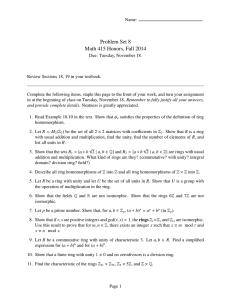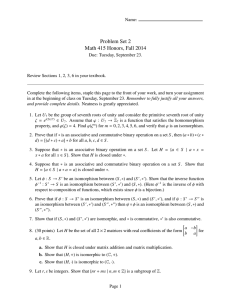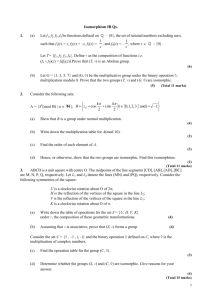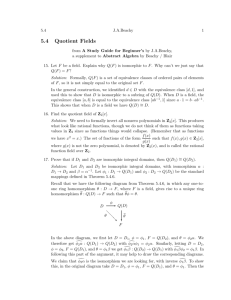ISOMORPHISM OF GENERALIZED TRIANGULAR MATRIX-RINGS AND RECOVERY OF TILES ASC˘
advertisement
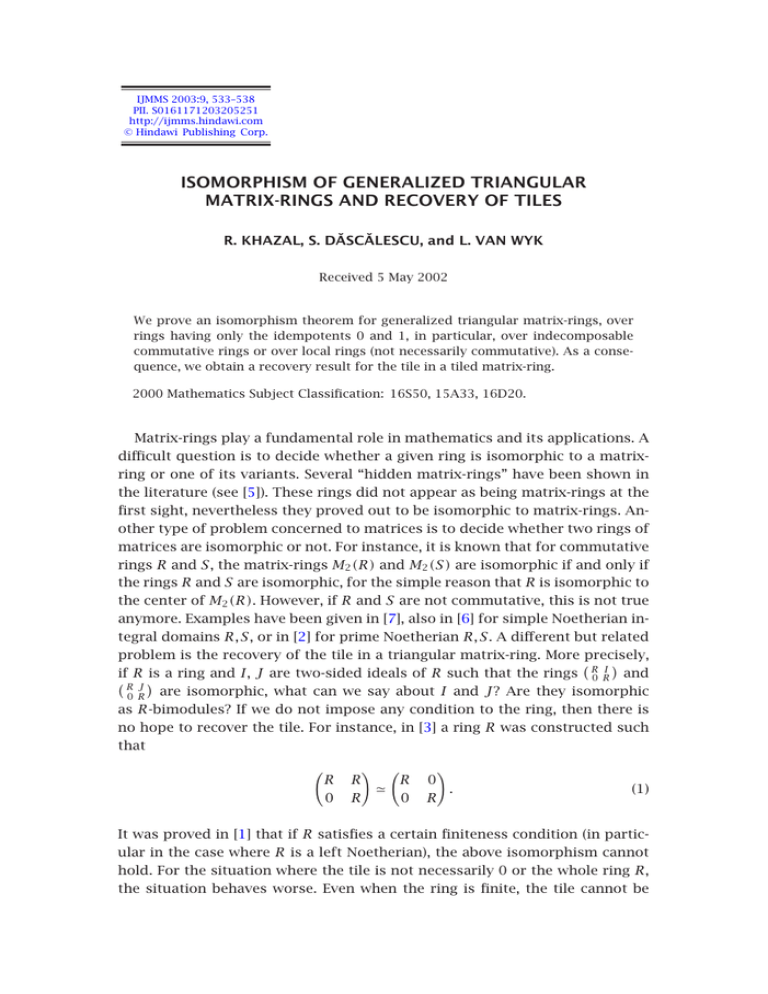
IJMMS 2003:9, 533–538
PII. S0161171203205251
http://ijmms.hindawi.com
© Hindawi Publishing Corp.
ISOMORPHISM OF GENERALIZED TRIANGULAR
MATRIX-RINGS AND RECOVERY OF TILES
R. KHAZAL, S. DĂSCĂLESCU, and L. VAN WYK
Received 5 May 2002
We prove an isomorphism theorem for generalized triangular matrix-rings, over
rings having only the idempotents 0 and 1, in particular, over indecomposable
commutative rings or over local rings (not necessarily commutative). As a consequence, we obtain a recovery result for the tile in a tiled matrix-ring.
2000 Mathematics Subject Classification: 16S50, 15A33, 16D20.
Matrix-rings play a fundamental role in mathematics and its applications. A
difficult question is to decide whether a given ring is isomorphic to a matrixring or one of its variants. Several “hidden matrix-rings” have been shown in
the literature (see [5]). These rings did not appear as being matrix-rings at the
first sight, nevertheless they proved out to be isomorphic to matrix-rings. Another type of problem concerned to matrices is to decide whether two rings of
matrices are isomorphic or not. For instance, it is known that for commutative
rings R and S, the matrix-rings M2 (R) and M2 (S) are isomorphic if and only if
the rings R and S are isomorphic, for the simple reason that R is isomorphic to
the center of M2 (R). However, if R and S are not commutative, this is not true
anymore. Examples have been given in [7], also in [6] for simple Noetherian integral domains R, S, or in [2] for prime Noetherian R, S. A different but related
problem is the recovery of the tile in a triangular matrix-ring. More precisely,
if R is a ring and I, J are two-sided ideals of R such that the rings R0 RI and
R J 0 R are isomorphic, what can we say about I and J? Are they isomorphic
as R-bimodules? If we do not impose any condition to the ring, then there is
no hope to recover the tile. For instance, in [3] a ring R was constructed such
that
R
0
R
R
R
0
0
.
R
(1)
It was proved in [1] that if R satisfies a certain finiteness condition (in particular in the case where R is a left Noetherian), the above isomorphism cannot
hold. For the situation where the tile is not necessarily 0 or the whole ring R,
the situation behaves worse. Even when the ring is finite, the tile cannot be
534
R. KHAZAL ET AL.
recovered. It was proved in [4] that if R =
0
I = 0
0
0
0
0
0
A
,
0
A
0 A
0 AA ,
0 0 A
0
J = 0
0
A is a ring, and
0
0
0
A
0
,
0
(2)
then the rings R0 RI and R0 RJ are isomorphic, while I and J are not isomorphic
as R-bimodules.
The aim of this paper is to obtain a recovery result for the tile in the case
where the underlying ring R has only trivial idempotents, that is, R has only two
idempotents, 0 and 1. Relevant examples of such rings are for instance: indecomposable commutative rings and local rings (not necessarily commutative).
In fact we can investigate the isomorphism among more general matrix-type
rings. Recall that if R and S are two rings, and M is an R, S-bimodule (this means
left R and right S), we can define the generalized triangular matrix-ring R0 M
S ,
with multiplication induced by the bimodule actions and the usual rule for
matrix multiplication. With this notation we can prove the following theorem.
Theorem 1. Let R and S be rings having only trivial idempotents, and let
R N M, N be two R, S-bimodules. Then a map φ : R0 M
S → 0 S is a ring isomorphism
if and only if there exist a ∈ N, f ∈ Aut(R), g ∈ Aut(S), and an isomorphism v :
M → N of additive groups satisfying v(r x) = f (r )v(x) and v(xs) = v(x)g(s)
for any x ∈ M, r ∈ R, s ∈ S, such that
r
φ
0
f (r )
x
=
s
0
f (r )a − ag(s) + v(x)
g(s)
,
(3)
for any r ∈ R, x ∈ M, and s ∈ S.
In particular, we obtain a recovery result for the tile. This is not exactly an
isomorphism, but an isomorphism relative to some automorphisms of the ring.
We recall that if f , g ∈ Aut(R), and X, Y are two R, R-bimodules, then an additive map v : X → Y is called an f , g-morphism if v(r xr ) = f (r )v(x)g(r ),
for any r , r ∈ R, x ∈ X.
Corollary 2 (recovery of the tile). Let R be a ring having only trivial idem
potents, and I, J be ideals of R. Then the matrix-rings R0 RI and R0 RJ are isomorphic if and only if I and J are f , g-isomorphic as the R, R-bimodules for
some f , g ∈ Aut(R).
A complete recovery of the tile (up to isomorphism) is obtained in some
special cases when the ring has only the trivial automorphism.
ISOMORPHISM OF GENERALIZED TRIANGULAR MATRIX-RINGS . . .
535
Corollary 3. Let R be a ring having only trivial idempotents such that, the
only automorphism of R is the identity. If I, J are ideals of R, then the matrix
rings R0 RI and R0 RJ are isomorphic if and only if I and J are isomorphic as
the R, R-bimodules.
Proof of Theorem 1. An element r0 xs ∈ R0 M
S is idempotent if and only
if r 2 = r , s 2 = s, and r x + xs = x. Since the only idempotents of R and S are 0
and 1, we have that any of r and s is either 0 or 1. If r = 0 and s = 0, we find
x = 0. If r = 1 and s = 1, we find again x = 0. If r = 1 and s = 0, then x can
be anything in M, and the same in the case where r = 0 and s = 1. Thus, apart
from 0 and the identity element, the idempotents of R0 M
S are the elements of
the form
1
ex =
0
0
fx =
0
x
,
0
x
,
1
x ∈ M,
(4)
x ∈ M.
It is easy to see that the following relations hold:
ex ey = ey ,
fx fy = fx ,
ex fy =
0
0
x +y
,
0
fx ey = 0,
(5)
for any x, y ∈ M. We denote by ez , fz , z ∈ N, the similar idempotents of R0 NS .
R M R N Let φ : 0 S → 0 S be a ring isomorphism. Then φ(e0 ) must be a nontrivial
idempotent of R0 NS . We distinguish two cases.
Case 1. We have φ(e0 ) = ea for some a ∈ N. Then if for some x ∈ M we
have φ(ex ) = fb for some b ∈ N, we see that
ea = φ e0 = φ ex e0 = φ ex φ e0 = fb ea = 0,
(6)
a contradiction. Therefore, φ(ex ) = eu(x)
for some u(x) ∈ N for any x ∈ M.
Then we have that
= f−u(−x)
.
φ fx = φ I2 − e−x = I2 − eu(−x)
(7)
Thus, for any x ∈ M we have
φ
0
0
x
0
= φ e0 fx = φ e0 φ fx = ea f−u(−x)
=
0
0
a − u(−x)
.
1
(8)
Denote v : M → N, v(x) = a−u(−x). Then clearly v is a morphism of additive
groups. Moreover, v is an isomorphism. Indeed, if φ−1 (ez ) = fh for some z ∈
N, h ∈ M, then φ(fh ) = ez , a contradiction. Thus φ({ex | x ∈ M}) = {ez | z ∈ N},
536
R. KHAZAL ET AL.
showing that u is surjective, so then v is also surjective. Obviously, v is injective.
Now
φ
r
0
0
r
= φ e0
0
0
r
0
= ea φ
0
0
0
R
∈
0
0
N
0
(9)
) h(r ) for some additive maps f : R → R, h : R → N. Since φ
thus φ r0 00 = f (r
0
0
is a ring morphism, we obtain that
f r1 r2 = f r1 f r2 ,
h r1 r2 = f r1 h r2 ,
for any r1 , r2 ∈ R. Similarly, one gets φ
g : S → S, p : S → N satisfying
0 0
0 s
f (1) = 1,
=
g s1 s2 = g s1 g s2 ,
p s1 s2 = p s1 g s2 ,
(10)
h(1) = a,
0 p(s)
0 g(s)
for some additive maps
g(1) = 1,
(11)
p(1) = −a.
Then h(r ) = h(r 1) = f (r )h(1) = f (r )a for any r ∈ R, and similarly p(s) =
−ag(s) for any s ∈ S. We obtain that
φ
r
0
x
r
=φ
s
0
0
0
+φ
0
0
f (r )
=
0
=
f (r )
0
x
0
+φ
0
0
0
s
0
v(x)
+
0
0
0
f (r )a
+
0
0
−ag(s)
g(s)
(12)
f (r )a − ag(s) + v(x)
,
g(s)
for any r ∈ R, s ∈ S, and x ∈ M. By using the relation
φ
r
0
x
s
r
0
x
s
=φ
r
0
x
r
φ
0
s
x
,
s
(13)
we obtain, by computing the (1, 2)-slots in the two sides, that f (r )v(x ) +
v(x)g(s ) = v(r x ) + v(xs ) for any r ∈ R, x, x ∈ M, s ∈ S. For s = 0, we
find v(r x ) = f (r )v(x ), and for r = 0, we obtain v xs = v(x)g s .
It remains to show that f and g are bijective. Clearly, ker(f ) = 0 since f (r ) =
0 implies φ r0 00 = 00 00 , and then r must be 0. Also f is surjective since for any
ISOMORPHISM OF GENERALIZED TRIANGULAR MATRIX-RINGS . . .
r
x
R
M
r
x
537
= b0 00 , in particular, f (r ) = b.
b ∈ R, there exists 0 s ∈ 0 S with φ 0 s
Thus f is a ring isomorphism, and so is g.
Case 2. We have φ(e0 ) = fa for some a ∈ N. Then for any x ∈ M, we have
that
fa = φ e0 = φ ex e0 = φ ex φ e0 = φ ex fa .
(14)
If φ(ex ) = ez for some x ∈ M, z ∈ N, we obtain that
fa = ez fa =
0
0
z+a
,
0
(15)
a contradiction. Thus, φ(ex ) = fu(x)
for any x ∈ M, where u : M → N is a map.
= e−u(−x)
, and then
Hence φ(fx ) = φ(I2 − e−x ) = I2 − fu(−x)
0
φ
0
x
= φ e0 fx = φ e0 φ fx = fu(0)
e−u(−x)
= 0,
0
(16)
a contradiction, for x ≠ 0. Therefore this case cannot occur.
For the other way around, it is straightforward to check that any map φ of
the given form is an isomorphism of rings.
Examples. (1) Let m and n be two nonnegative integers, and let Z be the
ring of integers which has only 0 and 1 as idempotents. Then by Corollary 3
and Z0 nZ
are isomorphic if and only if m = n.
the rings Z0 mZ
Z
Z
(2) Let Z[i] be the ring of Gauss integers which is a principal ideal domain
(PID), in particular,
it also has only
trivial idempotents. If x, y ∈ Z[i], then the
Z[i] yZ[i]
Z[i] xZ[i]
rings 0 Z[i] and 0 Z[i] are isomorphic if and only if either x = uy or
x = uy for some u ∈ {1, −1, i, −i}, where y denotes the complex conjugate of
y. Indeed, this follows from Corollary 2 and the fact that the only automorphisms of Z[i] are the identity and the complex conjugation.
Acknowledgment. The second author was supported by grant SM 10/01
of the Research Administration of Kuwait University.
References
[1]
[2]
[3]
[4]
[5]
G. Abrams, J. Haefner, and A. del Río, The isomorphism problem for incidence
rings, Pacific J. Math. 187 (1999), no. 2, 201–214.
A. W. Chatters, Nonisomorphic rings with isomorphic matrix rings, Proc. Edinburgh
Math. Soc. (2) 36 (1993), no. 2, 339–348.
S. Dăscălescu and L. van Wyk, Do isomorphic structural matrix rings have isomorphic graphs?, Proc. Amer. Math. Soc. 124 (1996), no. 5, 1385–1391.
, The recovery of the non-diagonal tile in a tiled triangular matrix ring, Indian J. Math. 42 (2000), no. 2, 167–173.
L. S. Levy, J. C. Robson, and J. T. Stafford, Hidden matrices, Proc. London Math.
Soc. (3) 69 (1994), no. 2, 277–308.
538
[6]
[7]
R. KHAZAL ET AL.
S. P. Smith, An example of a ring Morita equivalent to the Weyl algebra A1 , J.
Algebra 73 (1981), no. 2, 552–555.
R. G. Swan, Projective modules over group rings and maximal orders, Ann. of Math.
(2) 76 (1962), 55–61.
R. Khazal: Department of Mathematics and Computer Science, Faculty of Science,
Kuwait University, P.O. Box 5969, Safat 13060, Kuwait
E-mail address: khazal@mcs.sci.kuniv.edu.kw
S. Dăscălescu: Department of Mathematics and Computer Science, Faculty of Science,
Kuwait University, P.O. Box 5969, Safat 13060, Kuwait
E-mail address: sdascal@mcs.sci.kuniv.edu.kw
L. Van Wyk: Department of Mathematics, Stellenbosch University, Private Bag X1,
Stellenbosch 7602, South Africa
E-mail address: lvw@land.sun.ac.za


